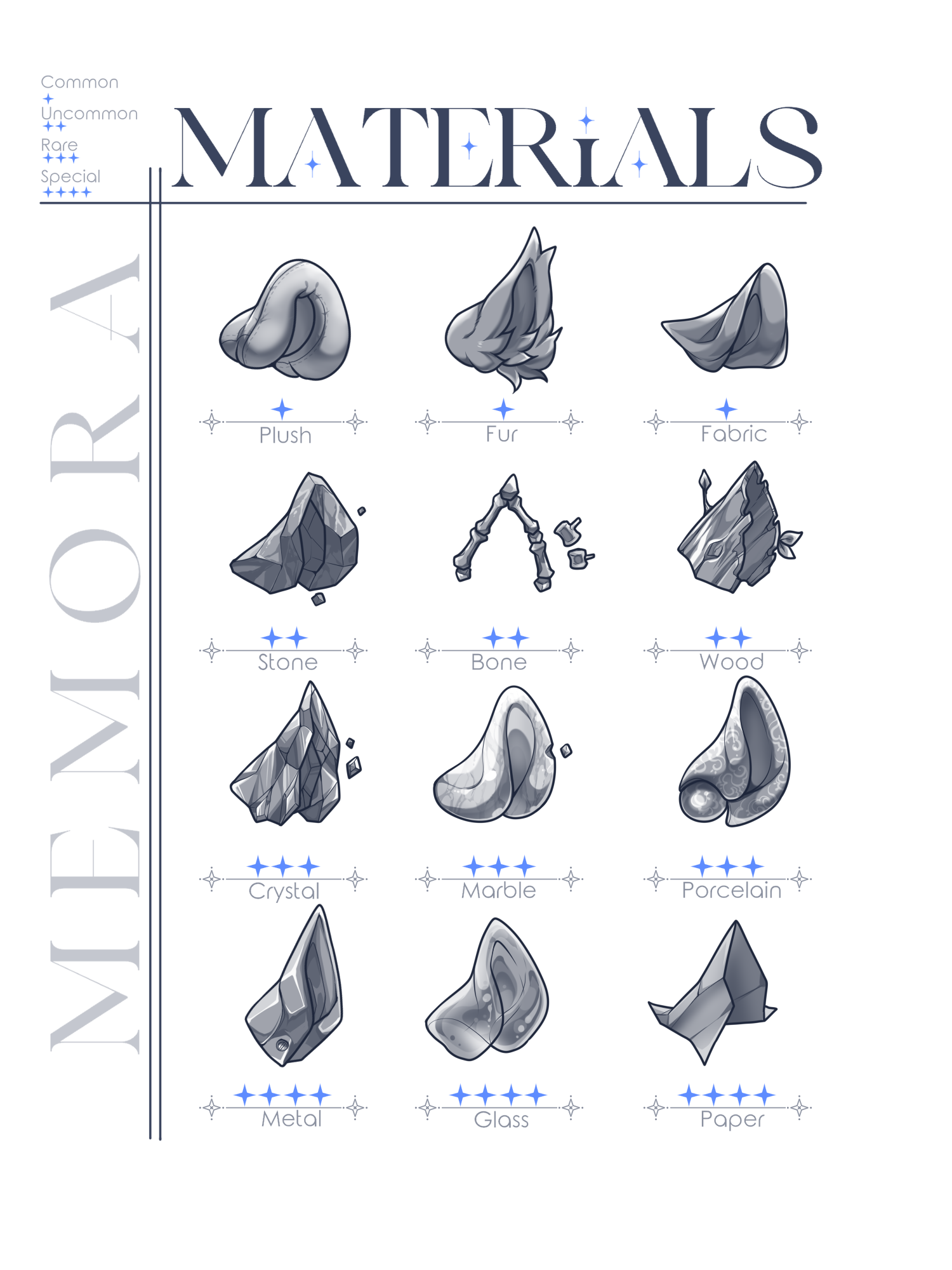- Material(s)
- What the object is primarily made of.
- Materials can be combined for a total of 2 main materials.
- plush+fur = common. plush+bone = uncommon. fur+crystal = rare. Whatever the higher rarity is in the combination will determine the rarity

- Wisps
- Memories of the deceased that do not make up the main body.
- Common Wisps will mainly appear as "will-o-the-wisps" or spherical and float aimlessly around the formed body. These wisps cannot be touched.
- Uncommon wisps will be able to form crude shapes similar to objects or animals, but without details. These wisps cannot be touched.
- Rare Wisps can form easily-identified semi-tangible shapes, meaning you can touch the wisps but with enough pressure, the wisp form will break down and need to re-assemble.
- Special wisps are fully tangible; meaning they can withstand pressure and interact with objects or people. These wisps often form extra features, such as limbs, for the Memora they belong to.

- Offerings
- Items or food that decorate the body of the Memora, and that differ from the original object the Memora was created from.
- Offerings can be small or large depending on rarity.
- Large offerings, i.e large instruments or any offering that was enlarged, are typically seen floating around the body.
- Multiple offerings are possible; rarity follows the same flow as the material combination rarity.

Mourning Veil
new required trait - any memora approved or myo's obtained before 9.22 have the option of opting into add this trait to their design or going with the 'no veil' common trait. More info in thread — visual guide TBA.
- No Mourning Veil - C
- Fabric, lace, mesh, tool, etc - C
- can be opaque or see through; if covering the whole face, must be transparent enough to see some of the face
- Unconventional - UC
- any material like glass, crystal, metal or paper that is used to make the mourning veil. Cannot be just a plane sheet of the material, should include some kind of design or beading.
- Feathered - UC
- Separate trait from the common wings triat - does not count towards the 'wings' common trait.
- Overgrown - R
- Flowers, vines, anything that 'grows' that is coming from the top of the head & down. Can be the same as the offering or not.
- Mask - R
- Cannot cover the whole face; must cover at least half at all times (left, right, or top half of the face)
- Does not count as the 'mask' offering.
- Wisps - S
- A veil made out of wisps, normally a dark color. This is the only trait that is shared between two rarities; if you're using the special wisps type, you can automatically use the wisps for a tail, ears, or body part.
Optional Traits
- Wings — C, UC, R, S
- The number of wing sets will determine the rarity of the trait; a single pair of wings is common, two is uncommon, three is rare, and four is special.
- Even if the object they're formed from has multiple sets of wings, they cannot be formed unless the Memora has the trait needed.
- Wings are not subjected to just feathered wings, and the sets can differ in type.
- The number of wing sets will determine the rarity of the trait; a single pair of wings is common, two is uncommon, three is rare, and four is special.
- Slight Damage — UC
- When the material is damaged but not extensive enough to warrant any immediate repairing, or has a small amount of stitching or patching done ( i.e not missing a limb. )
- Missing limb — UC
- A piece of the original object is missing or has broken off, and has reflected onto the Memora during it's formation. The point of breakage has been sealed in some way ( stitched up or covered to prevent more damage ) and thus cannot be repaired without re-damaging the material.
- Iridescence — UC
- Parts of the body have an iridescent shine or shimmer to them.
- Repaired — R
- Damage significant enough that it has been repaired with one of the original material types.
- Meaning if the original materials is metal and wood, the damage has been repaired with either wood or metal — it does not need to be the same type. ( original metal was gold, repaired was silver. original wood was oak and repaired was maple ). These repaired areas can show up as large scarred areas or a shift in color on the skin
- Damage significant enough that it has been repaired with one of the original material types.
- Repaired: Alteration — R
- When damage is repaired with a different type of material than the original.
- Meaning if the original materials are metal and wood, the damage has been repaired with anything that isn't metal or wood. Meaning porcelain, bone, fabric, etc.
- The different material cannot take up more than a fourth of the object overall.
- When damage is repaired with a different type of material than the original.
- Luminescence — R
- Parts of the body that glow in the dark.
- Heavy Damage — S
- Damage that could not be repaired because of the extensive damage done to the object, and has translated onto the formed body.
- Memora that have this trait will often times have difficulty maintaining their form, and parts of their body may fade in and out.
- When fading in and out, these areas may be completely see through to the other side of the Memora, or allow you to see inside of the Memoras body.
- Sometimes, these Memora will exhale or cough out something that looks like smoke.
